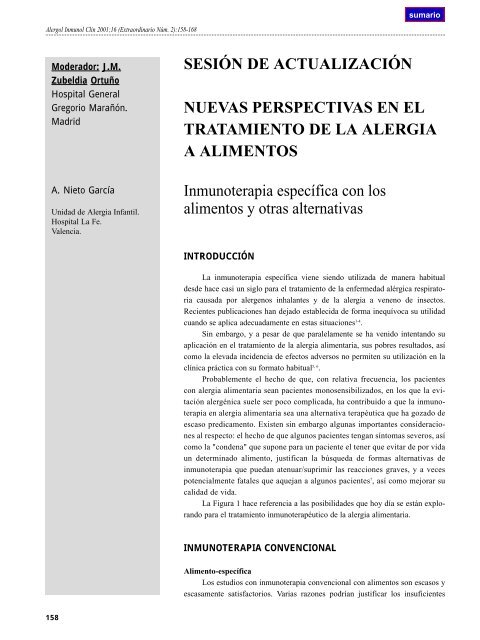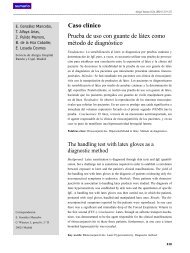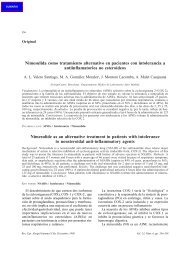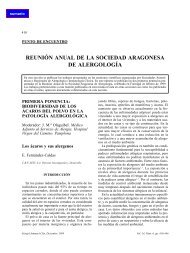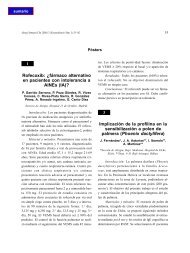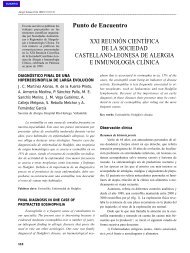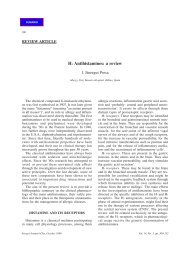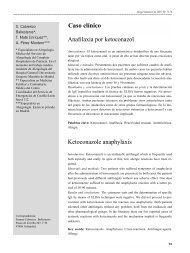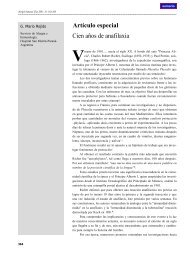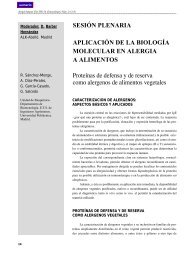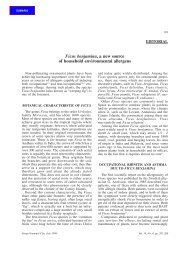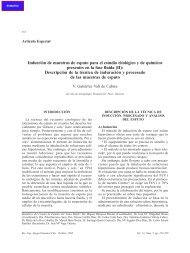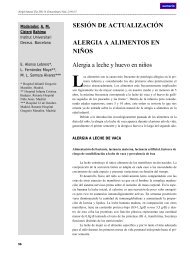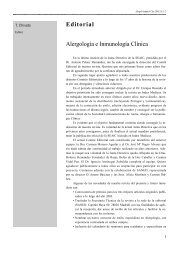Inmunoterapia específica con los alimentos y otras alternativas
Inmunoterapia específica con los alimentos y otras alternativas
Inmunoterapia específica con los alimentos y otras alternativas
You also want an ePaper? Increase the reach of your titles
YUMPU automatically turns print PDFs into web optimized ePapers that Google loves.
Alergol Inmunol Clin 2001;16 (Extraordinario Núm. 2):158-168<br />
Moderador: J.M.<br />
Zubeldia Ortuño<br />
Hospital General<br />
Gregorio Marañón.<br />
Madrid<br />
A. Nieto García<br />
Unidad de Alergia Infantil.<br />
Hospital La Fe.<br />
Valencia.<br />
158<br />
SESIÓN DE ACTUALIZACIÓN<br />
NUEVAS PERSPECTIVAS EN EL<br />
TRATAMIENTO DE LA ALERGIA<br />
A ALIMENTOS<br />
<strong>Inmunoterapia</strong> <strong>específica</strong> <strong>con</strong> <strong>los</strong><br />
<strong>alimentos</strong> y <strong>otras</strong> <strong>alternativas</strong><br />
INTRODUCCIÓN<br />
La inmunoterapia <strong>específica</strong> viene siendo utilizada de manera habitual<br />
desde hace casi un siglo para el tratamiento de la enfermedad alérgica respiratoria<br />
causada por alergenos inhalantes y de la alergia a veneno de insectos.<br />
Recientes publicaciones han dejado establecida de forma inequívoca su utilidad<br />
cuando se aplica adecuadamente en estas situaciones 1-4 .<br />
Sin embargo, y a pesar de que paralelamente se ha venido intentando su<br />
aplicación en el tratamiento de la alergia alimentaria, sus pobres resultados, así<br />
como la elevada incidencia de efectos adversos no permiten su utilización en la<br />
clínica práctica <strong>con</strong> su formato habitual 5, 6 .<br />
Probablemente el hecho de que, <strong>con</strong> relativa frecuencia, <strong>los</strong> pacientes<br />
<strong>con</strong> alergia alimentaria sean pacientes monosensibilizados, en <strong>los</strong> que la evitación<br />
alergénica suele ser poco complicada, ha <strong>con</strong>tribuido a que la inmunoterapia<br />
en alergia alimentaria sea una alternativa terapéutica que ha gozado de<br />
escaso predicamento. Existen sin embargo algunas importantes <strong>con</strong>sideraciones<br />
al respecto: el hecho de que algunos pacientes tengan síntomas severos, así<br />
como la "<strong>con</strong>dena" que supone para un paciente el tener que evitar de por vida<br />
un determinado alimento, justifican la búsqueda de formas <strong>alternativas</strong> de<br />
inmunoterapia que puedan atenuar/suprimir las reacciones graves, y a veces<br />
potencialmente fatales que aquejan a algunos pacientes 7 , así como mejorar su<br />
calidad de vida.<br />
La Figura 1 hace referencia a las posibilidades que hoy día se están explorando<br />
para el tratamiento inmunoterapéutico de la alergia alimentaria.<br />
INMUNOTERAPIA CONVENCIONAL<br />
Alimento-<strong>específica</strong><br />
Los estudios <strong>con</strong> inmunoterapia <strong>con</strong>vencional <strong>con</strong> <strong>alimentos</strong> son escasos y<br />
escasamente satisfactorios. Varias razones podrían justificar <strong>los</strong> insuficientes
INDUCCIÓN DIRECTA DE LA INVERSIÓN Th2 Th1<br />
<strong>Inmunoterapia</strong> <strong>con</strong>vencional Alimento-<strong>específica</strong><br />
<strong>Inmunoterapia</strong> <strong>con</strong> plásmidos<br />
<strong>Inmunoterapia</strong> <strong>con</strong> péptidos modificados<br />
<strong>Inmunoterapia</strong> oral<br />
Fig. 1. <strong>Inmunoterapia</strong> <strong>con</strong> <strong>alimentos</strong>. Posibles estrategias<br />
No Alimento-<strong>específica</strong><br />
INDUCCIÓN INDIRECTA DE LA INVERSIÓN Th2 Th1<br />
(BACTERIOTERAPIA)<br />
Probióticos-prebióticos<br />
Vacunas bacterianas <strong>con</strong> dinucleótidos CpG<br />
INDUCCIÓN COMBINADA DE LA INVERSIÓN Th2 Th1<br />
Vacunas alergeno-<strong>específica</strong>s + Coadyuvante <strong>con</strong><br />
dinucleótidos CpG<br />
BLOQUEO DE LA RESPUESTA ALÉRGICA<br />
Anti-IgE<br />
Desensibilización<br />
resultados de la inmunoterapia <strong>con</strong> <strong>alimentos</strong> cuando se<br />
comparan <strong>con</strong> la inmunoterapia <strong>con</strong> inhalantes:<br />
- Diferencias en el procesamiento entre alergenos<br />
inhalantes y alergenos alimentarios. Así, <strong>los</strong> alergenos inhalantes<br />
normalmente no sufren ningún proceso de degradación.<br />
Sin embargo, <strong>los</strong> alergenos alimentarios son sometidos<br />
a hidrólisis en el tubo digestivo lo que, posiblemente,<br />
aumenta la potencia alergénica de <strong>los</strong> mismos 8 . Por este<br />
motivo, entre el alimento en su forma nativa utilizado para<br />
la preparación del extracto alergénico, y el alimento que,<br />
tras un complejo proceso de digestión en el tubo digestivo<br />
es absorbido y produce la reacción alérgica, existen notables<br />
diferencias que, al menos parcialmente, podrían explicar la<br />
poca operatividad de la inmunoterapia <strong>con</strong>vencional <strong>con</strong> <strong>alimentos</strong>.<br />
- Diferencias en la dosis: las cantidades de alergenos<br />
inhalantes que penetran en las vías aéreas se miden habitualmente<br />
en nanogramos-microgramos; cuando se habla de<br />
alergenos alimentarios se está hablando de dosis de fracciones<br />
de kilo.<br />
- Diferencias en el procesamiento del alergeno por<br />
<strong>Inmunoterapia</strong> <strong>específica</strong> <strong>con</strong> <strong>los</strong> <strong>alimentos</strong> y <strong>otras</strong> <strong>alternativas</strong><br />
parte del tejido linfoide asociado al intestino (GALT) y en<br />
tejido linfoide asociado a <strong>los</strong> bronquios (BALT).<br />
- Composición del alimento, <strong>con</strong> <strong>con</strong>tenidos variables<br />
de diferentes proteínas alergénicas, a veces <strong>con</strong> múltiples<br />
reactividades cruzadas 9 .<br />
- Cofactores asociados (ejercicio, etc.).<br />
Aún así, algunos estudios exploran las posibilidades de<br />
uso de la inmunoterapia <strong>con</strong>vencional <strong>con</strong> <strong>alimentos</strong>. El más<br />
renombrado es un estudio doble ciego <strong>con</strong>trolado frente a placebo,<br />
utilizando un extracto de cacahuete. El fallecimiento de<br />
un paciente por un error (se le administró una dosis de mantenimiento<br />
de tratamiento activo, cuando pertenecía al grupo placebo)<br />
paralizó la inclusión de nuevos pacientes. No obstante,<br />
<strong>los</strong> resultados obtenidos a partir del reducido grupo de pacientes<br />
evaluables que habían sido incluídos antes del citado accidente,<br />
han sido publicados recientemente y las <strong>con</strong>clusiones<br />
finales ratifican que la elevada tasa de reacciones sistémicas no<br />
a<strong>con</strong>sejan el uso rutinario de esta forma de tratamiento 5-6 .<br />
Sin embargo, existen también referencias en las que se<br />
comunica el uso compasivo de inmunoterapia en casos de<br />
alergia alimentaria de gravedad extrema. Estas comunicaciones<br />
parecen sugerir que, en algunos casos especiales, no<br />
sería descabellado un ensayo <strong>con</strong> esta forma de tratamiento,<br />
sobre la base de un minuciosamente ponderado balance<br />
beneficio/riesgo 10 . En todo caso, ello tendría justificación<br />
únicamente en casos muy esporádicos, por lo que no parece<br />
que la inmunoterapia <strong>con</strong> <strong>alimentos</strong> en su formato <strong>con</strong>vencional<br />
pueda ser <strong>con</strong>siderada actualmente como una alternativa<br />
terapéutica de uso habitual en alergia alimentaria.<br />
No alimento-<strong>específica</strong><br />
El hecho de que determinados <strong>alimentos</strong> de origen<br />
vegetal (responsables de ciertos problemas como el síndrome<br />
de alergia oral) compartan epitopos comunes <strong>con</strong> algunos<br />
pólenes 11-14 , justifica la lógica suposición de que la inmunoterapia<br />
<strong>con</strong> pólenes podría paralelamente mejorar <strong>los</strong> síntomas<br />
relacionados <strong>con</strong> la ingestión de <strong>alimentos</strong> vegetales.<br />
Ello se ha visto <strong>con</strong>firmado en algunos estudios 15-16 , en <strong>los</strong><br />
que una inmunoterapia <strong>con</strong>vencional <strong>con</strong> polen de abedul,<br />
ambrosía o gramíneas (utilizada para el <strong>con</strong>trol de <strong>los</strong> síntomas<br />
respiratorios) mejoró <strong>los</strong> síntomas relacionados <strong>con</strong> la<br />
ingestión de melón, hinojo, pepino y/o manzana.<br />
INMUNOTERAPIA CON PLÁSMIDOS<br />
El uso de inmunoterapia génica en mode<strong>los</strong> murinos,<br />
utilizando plásmidos DNA (pDNA) programados para indu-<br />
159
A. Nieto García<br />
cir la producción de determinados alergenos (Ara h 2, Der<br />
p 5, Hev b 5, Bet v 1), es capaz de abolir la producción de<br />
IgE por inducción de una respuesta Th1 17 .<br />
Esta forma de inmunoterapia podría eventualmente ser<br />
aplicada en alergia alimentaria. De hecho, algunos mode<strong>los</strong><br />
animales en <strong>los</strong> que se estudia la inmunización <strong>con</strong> pDNA<br />
utilizan como alergeno sensibilizante la ovoalbúmina 18 .<br />
Las perspectivas de la inmunoterapia <strong>con</strong> pDNA son<br />
prometedoras y su eventual aplicación en alergia alimentaria<br />
no es descabellada. Sin embargo, existen incógnitas que<br />
deben ser resueltas antes de que su aplicación práctica<br />
pueda llevarse a cabo 19, 20 :<br />
- pDNA podría integrarse en el genoma del receptor<br />
disrupción genética malignización.<br />
- No está claro el resultado del uso de pDNA en animales<br />
previamente sensibilizados.<br />
- Está por determinar hasta qué punto el uso de pDNA<br />
induce inmunización o tolerancia y, por <strong>con</strong>siguiente, su eficacia<br />
a largo plazo.<br />
- La "ortodoxia" inmunológica sugiere que una célula productora<br />
de una proteína heteróloga podría ser re<strong>con</strong>ocida como<br />
extraña y atacada. Así, la inyección intramuscular de pDNA<br />
inductor de un determinado alergeno estimularía la producción<br />
del citado alergeno por parte de <strong>los</strong> miocitos, lo que, en teoría,<br />
podría suponer un riesgo de miositis autoinmune. En mode<strong>los</strong><br />
animales, sin embargo, esta eventualidad no ha sido observada.<br />
INMUNOTERAPIA CON PÉPTIDOS<br />
MODIFICADOS<br />
Los escasamente satisfactorios resultados de la inmunoterapia<br />
<strong>con</strong>vencional <strong>con</strong> cacahuete llevaron a <strong>con</strong>siderar<br />
la posibilidad de que la predigestión de este alimento pudiera<br />
modificar su potencialidad alergénica, <strong>con</strong>servando su<br />
poder inmunogénico.<br />
Así, estudios in vitro documentan que extractos de<br />
cacahuete digeridos <strong>con</strong> pepsina pierden en gran medida su<br />
capacidad para fijar IgE, manteniendo no obstante una aceptable<br />
potencialidad inmunogénica (expresada por su capacidad<br />
para inducir respuestas proliferativas de células T) 21 .<br />
La producción de fragmentos recombinantes de alergenos<br />
parece indicar que, al menos en algunos casos, las fracciones<br />
protéicas así obtenidas pierden gran parte de la aptitud<br />
de la proteína íntegra para fijar IgE. Ello ha sido observado<br />
<strong>con</strong> ciertos alergenos inhalantes, <strong>con</strong>cretamente <strong>con</strong> el alergeno<br />
mayor de abedul (Bet v 1). Dos fragmentos recombinantes<br />
de Bet v 1 (aminoácidos 1-74 y aminoácidos 75-160<br />
160<br />
de Bet v 1) sufrieron una notable alteración de la estructura<br />
proteica tridimensional y una casi total pérdida de la capacidad<br />
de dichos fragmentos para fijar IgE y, <strong>con</strong>secuentemente,<br />
para inducir la liberación de histamina a partir de basófi<strong>los</strong> de<br />
pacientes alérgicos. Sin embargo, ambos fragmentos <strong>con</strong>servaron<br />
la mayoría de <strong>los</strong> epitopos para células T 22, 23 . Estudios<br />
preliminares sugieren la posibililidad de desarrollar proteínas<br />
alimentarias hipoalergénicas que mantengan su capacidad<br />
para inducir proliferación de células T y que permitan una<br />
inmunoterapia <strong>con</strong> <strong>alimentos</strong> eficaz y segura 24, 25 .<br />
INMUNOTERAPIA ORAL<br />
Algunas publicaciones hacen referencia a <strong>los</strong> efectos<br />
clínicos y biológicos de la inmunoterapia por vía oral <strong>con</strong><br />
cápsulas o microcápsulas entéricas <strong>con</strong>teniendo alergenos<br />
inhalantes (ambrosía y abedul), lo cual haría posible eludir<br />
la barrera gástrica y permitiría su absorción intestinal 26-28 . En<br />
todo caso, <strong>los</strong> efectos clínicos no son excesivamente <strong>con</strong>sistentes<br />
y algún estudio no <strong>con</strong>sigue demostrar efectos relevantes<br />
29 . No obstante, en uno de estos estudios se pudo comprobar<br />
que en algunos pacientes vacunados <strong>con</strong> polen de<br />
abedul por vía oral mejoró la sintomatología <strong>con</strong>comitante<br />
relacionada <strong>con</strong> la ingestión de ciertos <strong>alimentos</strong> (frutos<br />
secos, manzana, plátano, etc).<br />
Parece racional <strong>con</strong>siderar la inmunoterapia por vía<br />
oral en alergia alimentaria, puesto que su administración por<br />
la vía a través de la cual se producen tanto la sensibilización<br />
como la absorción de <strong>los</strong> alergenos responsables de la sintomatología<br />
clínica, podría inducir modificaciones de la respuesta<br />
inmune no sólo a nivel sistémico, sino también en el<br />
sistema inmune asociado al intestino. Pero al mismo tiempo,<br />
éste puede ser su mayor in<strong>con</strong>veniente: en efecto, cantidades<br />
de alimento suficientes como para inducir tolerancia<br />
inmunológica pueden ser a la vez demasiado elevadas como<br />
para que no desencadenen efectos adversos.<br />
Una alternativa futura a la inmunoterapia oral <strong>con</strong>vencional<br />
parece emerger de un reciente estudio que combina la<br />
inmunoterapia oral <strong>con</strong> un plásmido inductor de uno de <strong>los</strong><br />
alergenos mayores del cacahuete (Ara h 2) 30 . En este estudio<br />
se analizan <strong>los</strong> efectos que en un modelo murino de anafilaxia<br />
alimentaria tiene la administración por vía oral de un gen<br />
inductor de Ara h 2 incluido en partículas de chitosan. El<br />
chitosan es un polisacárido natural biocompatible y biodegradable,<br />
presente en <strong>los</strong> caparazones de <strong>los</strong> crustáceos, que<br />
se ha utilizado ampliamente para permitir la administración<br />
por vía oral de fármacos. En este estudio:
1. El plásmido inductor de Ara h 2 fue protegido frente<br />
a la digestión mediante su inclusión dentro de nanopartículas<br />
de chitosan de entre 100 y 200 nm. de diámetro.<br />
2. El chitosan, aparte de ser resistente a la digestión,<br />
posee una elevada adhesividad a la superficie mucosa intestinal,<br />
lo que permitió una mayor captación por parte las<br />
células epiteliales y, <strong>con</strong>secuentemente, una mayor expresión<br />
del plásmido <strong>con</strong>tenido en su interior.<br />
Los ratones así inmunizados y ulteriormente provocados<br />
<strong>con</strong> Ara h 2 mostraron una sustancial reducción de <strong>los</strong><br />
niveles de IgE <strong>específica</strong>, así como un relevante aumento de<br />
<strong>los</strong> niveles de IgG2a <strong>específica</strong> y de IgA secretoria fecal<br />
comparado <strong>con</strong> <strong>los</strong> animales que sirvieron como <strong>con</strong>troles.<br />
Pero, además de ello, experimentaron un score de síntomas<br />
y niveles de histamina plasmática tras la provocación significativamente<br />
menores.<br />
PROBIÓTICOS-PREBIÓTICOS<br />
Los primeros y más potentes estímu<strong>los</strong> antigénicos<br />
que tienen lugar a partir del nacimiento vienen determinados<br />
por la colonización intestinal. Es lógico suponer por<br />
tanto que la naturaleza de <strong>los</strong> estímu<strong>los</strong> bacterianos durante<br />
las primeras semanas de vida tendrá una importancia decisiva<br />
en el desarrollo de las respuestas inmunes ulteriores, y<br />
quizá determine de por vida el desarrollo de una respuesta<br />
inmune equilibrada. Son significativas las evidencias que<br />
demuestran que existen diferencias cuantitativas y cualitativas<br />
en el patrón de colonización intestinal entre <strong>los</strong> recién<br />
nacidos de países industrializados y de países en vías de<br />
desarrollo 31 , y que estas diferencias son sorprendentemente<br />
estables a lo largo del tiempo. Pero, además, se han observado<br />
asimismo diferencias en el patrón de colonización<br />
intestinal entre niños alérgicos y no alérgicos, teniendo estos<br />
últimos una más notable presencia de Lactobaci<strong>los</strong> y<br />
Bifidobacterias que <strong>los</strong> alérgicos 32,33 .<br />
Teniendo en cuenta que uno de <strong>los</strong> factores clave para<br />
el desarrollo de alergia tiene que ver <strong>con</strong> alteraciones en la<br />
función de la barrera intestinal y que determinadas bacterias<br />
saprofitas <strong>con</strong>tribuyen de forma decisiva al cierre fisiológico<br />
de la citada barrera intestinal 34 , parece razonable suponer<br />
que una colonización intestinal más "fisiológica" pudiera<br />
<strong>con</strong>tribuir a la prevención primaria, secundaria y terciaria de<br />
<strong>los</strong> problemas alérgicos.<br />
En este sentido son ya numerosos <strong>los</strong> estudios que<br />
prueban la capacidad de bacterias probióticas como una<br />
eventual y novedosa estrategia inmunoterapéutica 34-39 .<br />
<strong>Inmunoterapia</strong> <strong>específica</strong> <strong>con</strong> <strong>los</strong> <strong>alimentos</strong> y <strong>otras</strong> <strong>alternativas</strong><br />
VACUNAS BACTERIANAS CON<br />
DINUCLEÓTIDOS CpG (CpG ODN)<br />
Diversos estudios realizados en animales de experimentación<br />
ilustran el efecto que fragmentos palindrómicos<br />
de DNA bacteriano <strong>con</strong>teniendo secuencias no metiladas<br />
Citosina-Guanina (CpG) tienen en la inducción de respuestas<br />
Th1 y en el mantenimiento de dichas respuestas de una<br />
forma sostenida 40 . Ello ha sido comprobado en estudios realizados<br />
en ratones sensibilizados <strong>con</strong> antígeno de huevo de<br />
Schistosoma Mansoni 41 , así como frente a alergenos inhalantes.<br />
Ello permite especular <strong>con</strong> la posibilidad de que esta<br />
forma de inmunoterapia pudiera ser utilizada en el tratamiento<br />
de enfermedades alérgicas, y <strong>con</strong>cretamente en alergia<br />
alimentaria, pero incluso en la prevención primaria en<br />
personas de riesgo alérgico.<br />
Existen no obstante cuestiones que deben ser resueltas<br />
antes de que esta forma de tratamiento pueda ser utilizada.<br />
No se <strong>con</strong>oce si una inducción in<strong>específica</strong>, potente y sostenida<br />
de una respuesta Th1 mediante ODN CpG pudiera dar<br />
lugar a enfermedades de tipo autoinmune 40 .<br />
Se ha sugerido asimismo la posibilidad de utilizar en la<br />
inmunoterapia otros adyuvantes Th1 de origen bacteriano,<br />
como el Mycobaterium Vaccae 42 o la Listeria Monocitogenes 43 .<br />
TERAPÉUTICAS COMBINADAS<br />
Han sido publicados recientemente dos estudios que<br />
utilizan alergeno acoplado a CpG ODN. En uno de el<strong>los</strong> se<br />
inyecta a ratones CpG ODN acoplado a un plásmido codificado<br />
para inducir la producción de Bet v1. Ello produce una<br />
notable estimulación de la producción de IFNγ a partir de<br />
células esplénicas 44 .<br />
Un segundo estudio utiliza ODN CpG acoplado al<br />
alergeno mayor de la ambrosía (Amb a 1). Dicho <strong>con</strong>jugado<br />
era inyectado a ratones y se pudo comprobar que era capaz<br />
de inducir una respuesta prolongada de tipo Th1 (<strong>con</strong> notable<br />
incremento de IgG2a e IFNγ) tanto en ratones previamente<br />
sensibilizados a Amb a 1, como en ratones no sensibilizados<br />
45 .<br />
Un estudio de seguridad in vivo mediante Prick-test<br />
realizado en humanos <strong>con</strong>cluyó que el <strong>con</strong>jugado ODN<br />
CpG + Amb a 1 resultó menos alergénico que el extracto<br />
aislado de Amb a 1 46 .<br />
Así, datos preliminares parecen sugerir que el <strong>con</strong>jugado<br />
ODN CpG + alergeno reduce significativamente la capacidad<br />
para fijar IgE del alergeno utilizado 40 , lo cual podría<br />
161
A. Nieto García<br />
permitir el uso de esta forma de inmunoterapia <strong>con</strong> alergenos<br />
que, como el caso de <strong>los</strong> <strong>alimentos</strong>, han causado problemas<br />
por la elevada tasa de reacciones sistémicas cuando se utiliza<br />
en su forma <strong>con</strong>vencional. Asimismo, la inducción de una<br />
respuesta Th1 alergeno-<strong>específica</strong> podría eludir <strong>los</strong> problemas<br />
mencionados en el epígrafe precedente en relación <strong>con</strong><br />
la hipotética posibilidad de producir efectos adversos de tipo<br />
autoinmune como <strong>con</strong>secuencia de una respuesta Th1 generalizada<br />
e in<strong>específica</strong> inducida por CpG ODN.<br />
ANTI-IgE<br />
Si bien <strong>los</strong> estudios hasta ahora disponibles han sido<br />
efectuados en pacientes <strong>con</strong> enfermedad alérgica respiratoria<br />
(asma y rinitis), la próxima aparición en el mercado del anticuerpo<br />
monoclonal anti-IgE abre una perspectiva para su uso<br />
en otro tipo de patología alérgica IgE-mediada, especialmente<br />
en alergias graves, sobre todo anafilaxia por veneno de<br />
himenópteros y anafilaxia alimentaria 8 . Una de las ventajas<br />
de esta forma de tratamiento es su capacidad para el tratamiento<br />
de sensibilizaciones múltiples, independientemente<br />
de la especificidad alergénica.<br />
Esta forma de tratamiento bloquea el acoplamiento del<br />
alergeno a la IgE fijada a la membrana de mastocitos/basófi<strong>los</strong>.<br />
Sin embargo, y en tanto todavía no se <strong>con</strong>oce si el uso del<br />
anticuerpo anti IgE es capaz de producir una infrarregulación<br />
permanente de la producción de IgE, en principio parece<br />
razonable suponer que la efectividad de esta forma de tratamiento<br />
cesaría poco después de que fuera suspendido su uso.<br />
En todo caso, es posible que el anticuerpo monoclonal<br />
anti-IgE pueda ser utilizado de forma temporal <strong>con</strong> el fin de<br />
disminuir la reactividad alergénica del paciente y permitir el<br />
uso combinado de alguna otra forma de tratamiento inmunoterapéutico,<br />
reduciendo el riesgo de que este último produzca<br />
efectos adversos severos 47 .<br />
DESENSIBILIZACIÓN<br />
Han sido publicados protoco<strong>los</strong> para la desensibilización<br />
alimentaria en pacientes <strong>con</strong> grave anafilaxia 48-50 . Los<br />
resultados en <strong>los</strong> casos esporádicos en <strong>los</strong> que esta forma de<br />
tratamiento ha sido utilizada son ciertamente positivos, no<br />
sólo desde el punto de vista clínico, sino que ha sido descrito<br />
algún caso <strong>con</strong> negativización incluso de <strong>los</strong> tests cutáneos,<br />
disminución de IgE-<strong>específica</strong>, disminución de IL-4 y<br />
aumento de IFN-γ 50 .<br />
162<br />
El principal in<strong>con</strong>veniente nuevamente radica en el<br />
hecho de que no se <strong>con</strong>oce <strong>con</strong> certeza la duración del efecto<br />
y, por tanto, hasta qué punto y durante cuánto tiempo <strong>los</strong><br />
pacientes pueden dejar de tomar el alimento sin que ello<br />
suponga un riesgo. La experiencia de esta forma de tratamiento<br />
en alergia medicamentosa permite suponer <strong>con</strong> fundamento<br />
que el tiempo no sería demasiado prolongado.<br />
RESUMEN<br />
Los <strong>con</strong>tinuos avances en el <strong>con</strong>ocimiento de la fisiopatología<br />
de las enfermedades alérgicas (en particular de la<br />
alergia alimentaria), así como en la <strong>con</strong>figuración estructural<br />
de <strong>los</strong> alergenos alimentarios, permiten suponer que<br />
existe base para el desarrollo de estrategias inmunoterapéuticas<br />
que modifiquen la hiperrespuesta frente a <strong>alimentos</strong><br />
que sufren algunos pacientes.<br />
Es razonable esperar que las emergentes técnicas de<br />
ingeniería genética permitan elaborar antígenos <strong>con</strong> reducida<br />
capacidad alergénica que, combinados <strong>con</strong> coadyuvantes<br />
inductores de respuestas Th1 permitan <strong>con</strong>figurar<br />
inmunoterapias "a la medida" de las necesidades de cada<br />
paciente.<br />
Contrariamente a lo que <strong>con</strong> frecuencia se sostiene en<br />
otros foros, no es razonable resignarse a que un paciente<br />
deba estar sometido de por vida al riesgo de una reacción<br />
grave por la ingestión inadvertida o accidental del alimento<br />
al cual está sensibilizado, siendo que, al igual que en <strong>otras</strong><br />
enfermedades de base inmunológica, el horizonte de tratamientos<br />
inmunoterapéuticos está ya a la vista.<br />
REFERENCIAS BIBLIOGRÁFICAS<br />
1. Abramson MJ, Puy RM, Weiner JM. Is allergen immunotherapy<br />
effective in asthma? Am J Respir Crit Care Med 1995;151:969-974.<br />
2. Abramson MJ. Allergen immunotherapy in asthma. In: The<br />
Cochrane Collaboration. Oxford: Update Software ed: Cochrane<br />
Library; 1998.<br />
3. Abramson MJ. Allergen immunotherapy in asthma. Allergy 1998.<br />
4. Bousquet J, Lockey RF, Malling H-J. WHO Position Paper Allergen<br />
Immunotherapy: Therapeutic vaccines for allergic diseases. Allergy<br />
1998;44:1S-42S.<br />
5. Oppenheimer JJ, Nelson HS, Bock SA, Christensen F, Leung DYM.<br />
Treatment of peanut allergy with rush immunotherapy. J Allergy Clin<br />
Immunol 1992;90:256-262.<br />
6. Nelson HS, Lahr J, Rule R, Bock A, Leung D. Treatment of anaphylactic<br />
sensitivity to peanuts by immunotherapy with injections of aqueous<br />
peanut extract. J Allergy Clin Immunol 1997;99:744-751.<br />
7. Wüthrich B. Lethal or life-threatening allergic reactions to food.<br />
Invest Allergol Clin Immunol 2000;10:59-65.
8. Sampson HA. Food allergy: from biology toward therapy. Hosp Pract<br />
(Off Ed) 2000;35(5):67-70, 73-6, 79 passim.<br />
9. Breiteneder H, Ebner C. Molecular and biochemical classification<br />
of plant-derived food allergens. J Allergy Clin Immunol 2000;106:<br />
27-36.<br />
10. Casimir G, Cuvelier P, Allard S, Duchateau J. Life-threatening fish<br />
allergy successfully treated with immunotherapy. Pediatr Allergy<br />
Immunol 1997;8:103-105.<br />
11. Kazemi-Shirazi L, Pauli G, Purohit A, Spitzauer S, Fr]oschl R,<br />
Hoffmann-Sommergruber K, et al. Quantitative IgE inhibition experiments<br />
with purified recombinant allergens indicate pollen-derived<br />
allergens as the sensitizing agents responsible for many forms of<br />
plant food allergy. J Allergy Clin Immunol 2000;105(1 Pt 1):116-<br />
125.<br />
12. Son DY, Scheurer S, Hoffmann A, Haustein D, Vieths S. Pollen-related<br />
food allergy: cloning and immunological analysis of isoforms and<br />
mutants of Mal d 1, the major apple allergen, and Bet v 1, the major<br />
birch pollen allergen. Eur J Nutr 1999;38:201-215.<br />
13. Ebner C, Hirschwehr R, Bauer L, Breitneder H, Valenta R, Ebner<br />
H, et al. Identification of allergens in fruits and vegetables: IgE crossreactivities<br />
with the important birch pollen allergens Bet v1 and Bet v2<br />
(birch profilin). J Allergy Clin Immunol 1995;95:962-969.<br />
14. Bircher AJ, Van Melle G, Haller E, Curty B, Frei PC. IgE to food<br />
allergens are highly prevalent in patients allergic to pollens, with and<br />
without symptoms of food allergy. Clin Exp Allergy 1994;24:367-374.<br />
15. Asero R. Effects of birch pollen-specific immunotherapy on apple<br />
allergy in birch pollen-hypersensitive patients. Clin Exp Allergy<br />
1998;28:1368-1373.<br />
16. Asero R. Fennel, cucumber, and melon allergy successfully treated<br />
with pollen-specific injection immunotherapy. Ann Allergy Asthma<br />
Immunol 2000;84:460-462.<br />
17. Spiegelberg HL, Orozco EM, Roman M, Raz E. DNA immunization:<br />
a novel approach to allergen-specific immunotherapy. Allergy<br />
1997;52:964-970.<br />
18. Corry DB, Folkesson HG, Warnock ML, Erle DJ, Matthay MA,<br />
Wiener-Kronish JP, et al. Interleukin 4, but not interleukin 5 or eosinophils,<br />
is required in a murine model of acute airway hyperreactivity.<br />
J Exp Med 1996;183:109-117.<br />
19. Moffatt M, Cookson W. Naked DNA: new shots for allergy? Nat<br />
Med 1996;2:515-516.<br />
20. Goodman JS, Van Uden JH, Kobayashi H, Broide D, Raz E. DNA<br />
immunotherapeutics: New potential treatment modalities for allergic<br />
disease. In Arch Allergy Immunol 1998;116:177-187.<br />
21. Hong SJ, Michael JG, Fehringer A, Leung DY. Pepsin-digested peanut<br />
<strong>con</strong>tains T-cell epitopes but no IgE epitopes. J Allergy Clin Immunol<br />
1999;104(2 Pt 1):473-478.<br />
22. Vrtala S, Hirtenlehner K, Vangelista L, Pastore A, Eichler HG, Sperr<br />
WR, et al. Division of the major birch pollen allergen, Bet v 1, into two<br />
non-anaphylactic fragments. Int Arch Allergy Immunol 1997;113:246-<br />
248.<br />
23. Ebner C, Szepfalusi Z, Ferreira F, Jilek A, Valenta R, Parronchi P, et<br />
al. Identication of multiple T cell epitopes on Bet v 1, the major birch<br />
pollen allergen, using T cell clones and overlapping peptides. J<br />
Immunol 1993;150:1047-1054.<br />
24. Stanley JS, King N, Burks AW, Huang SK, Sampson H, Cockrell G,<br />
et al. Identification and mutational analysis of the immunodominant<br />
IgE binding epitopes of the major peanut allergen Ara h 2. Arch<br />
Biochem Biophys 1997;342:224-253.<br />
25. Burks AW, King N, Bannon GA. Modification of a major peanut<br />
allergen leads to <strong>los</strong>s of IgE binding. Int Arch Allergy Immunol<br />
1999;118:313-314.<br />
26. Litwin A, Flanagan M, Entis G, Gottschlich G, Esch R, Gartside P,<br />
et al. Immunoligic effects of encapsulated short ragweed extract: a<br />
<strong>Inmunoterapia</strong> <strong>específica</strong> <strong>con</strong> <strong>los</strong> <strong>alimentos</strong> y <strong>otras</strong> <strong>alternativas</strong><br />
potent new agent for oral immunotherapy. Ann Allergy Asthma<br />
Immunol 1996;77:132-138.<br />
27. Taudorf E, Laursen LC, Lanner A, Björstén B, Dreborg S, Soborg S,<br />
et al. Oral immunotherapy in birch pollen hay fever. J Allergy Clin<br />
Immunol 1987;80:153-161.<br />
28. Van Deusen MA, Angelini BL, Cordoro KM, Seiler BA, Wood L,<br />
Skoner DP. Efficacy and safety or oral immunotherapy with short ragweed<br />
extract. Ann Allergy Asthma Immunol 1997;78:573-580.<br />
29. Oppenheimer J, Areson JG, Nelson HS. Safety and efficacy of oral<br />
immunotherapy with standardized cat extract. J Allergy Clin Immunol<br />
1994;93:61-67.<br />
30. Roy K, Mao H-Q, Huang S-K, Leong KW. Oral gene delivery with<br />
chitosan-DNA nanoparticles generates immunologic protection in a<br />
murine model of peanut allergy. Nat Med 1999;5:387-391.<br />
31. Adlerberth I, Carlsson B, De Man P, Jalil F, Khan SR, Larsson P, et<br />
al. Intestinal colonization with Enterobacteriaceae in Pakistani ans<br />
Swedish hospital-delivered infants. Acta Paediatr Scand<br />
1991;80:602-610.<br />
32. Sepp E, Julge K, Vasar M, Naaber P, Bjorksten B, Mikelsaar M.<br />
Intestinal microflora of Estonian and Swedish infants. Acta Paediatr<br />
1997;86:956-961.<br />
33. Bjorksten B, Naaber P, Sepp E, Mikelsaar M. The intestinal microflora<br />
in allergic Estonian and Swedish 2-year-old children. Clin Exp<br />
Allergy 1999;29:342-346.<br />
34. Isolauri E, Salminen S, Mattila-Sandholm T. New functional foods<br />
in the treatment of food allergy. Ann Med 1999;31:299-302.<br />
35. Kalliomäki M, Salminen S, Arvilommi H, Kero P, Koskinen P,<br />
Isolauri E. Probiotics in primary prevention of atopic disease: a randomised<br />
placebo-<strong>con</strong>trolled trial. Lancet 2001;357:1076-1079.<br />
36. Majamaa H, Isolauri E. Probiotics: a novel approach in the management<br />
of food allergy. J Allergy Clin Immunol 1997;99:179-185.<br />
37. Pelto L, Isolauri E, Lilius EM, Nuutila J, Salminen S. Probiotic bacteria<br />
down-regulate the milk-induced inflammatory response in milkhypersensitive<br />
subjects but have an immunostimulatory effect in<br />
healthy subjects. Clin Exp Allergy 1998;28:1474-1479.<br />
38. Sütas Y, Hurme M, Isolauri E. Down-regulation of anti-CD3 antibody-induced<br />
IL-4 production by bovine caseins hydrolised with<br />
Lactobacillus GG-derived enzymes. Scand J Immunol 1996;43:687-<br />
689.<br />
39. Pessi T, Sütas Y, Hurme M, Isolauri E. Interleukin-10 generation in<br />
atopic children following oral Lactobacillus rhamnosus GG. Clin Exp<br />
Allergy 2000;30:1804-1808.<br />
40. Wild JS, Sur S. CpG oligonucleotide modulation of allergic inflammation.<br />
Allergy 2001;56:365-376.<br />
41. Kline JN, Waldschmidt TJ, Businga TR, Lemish JE, Weinstock JV,<br />
Thorne PS, et al. Cutting edge: Modulation of airway inflammation by<br />
CpG oligodeoxynucleotides in a murine model of asthma. J Immunol<br />
1998;160:2555-2559.<br />
42. Arkwright PD, David TJ. Intradermal administration of a killed<br />
Mycobacterium Vaccae suspension (SRL 172) is associated with<br />
improvement in atopic dermatitis in children with moderate-to-severe<br />
disease. J Allergy Clin Immunol 2001;107:531-534.<br />
43. Yeung VP, Gieni RS, Umetsu DF, DeKruyff RH. Heta-killed Listeria<br />
Monocytogenes as an adjuvant coverts established murine Th2-dominated<br />
responses into Th1-dominated responses. J Immunol<br />
1998;161:4146-4152.<br />
44. Hartl A, Kiesslich J, Weiss R. Immune responses after immunization<br />
with plasmid DNA encoding Bet v1, the major allergen of birch<br />
pollen. J Allergy Clin Immunol 1999;103:107-113.<br />
45. Tighe H, Takabayashi K, Schwartz D, Van Nest G, Tuck S, Eiden<br />
JJ, et al. Conjugation of immunostimulatory DNA to the short ragweed<br />
163
S. B. Lehrer, et al<br />
allergen Amb a 1 reduces its allergenicity. J Allergy Clin Immunol<br />
2000;106:124-134.<br />
46. Creticos PS, Eiden JJ, Balcer SL, Van Nest G, Kagey-Sobotka A,<br />
Tuck SF, et al. Immunostimulatory oligonucleotides <strong>con</strong>jugated to Amb<br />
a 1: safety, skin test reactivity, and basophil histamine release. J Allergy<br />
Clin Immunol 2000;105:A215.<br />
47. Sampson HA. Food allergy. Part 2: Diagnosis and management. J<br />
Allergy Clin Immunol 1999;103:981-989.<br />
Samuel B. Lehrer*,<br />
Wesley Burks**<br />
*Research Professor of<br />
Medicine<br />
Section of Clinical<br />
Immunology, Allergy, and<br />
Rheumatology<br />
Department of Medicine<br />
Tulane University School of<br />
Medicine.<br />
**Professor of Pediatrics<br />
Arkansas Children’s Hospital<br />
Department of Pediatric<br />
Allergy and Immunology<br />
University of Arkansas for<br />
Medical Sciences.<br />
164<br />
48. Bauer A, Ekanayake Mudiyanselage S, Wigger-Alberti W, Elsner P.<br />
Oral rush desensitization to milk. Allergy 1999;54:894-895.<br />
49. Nucera E, Schiavino D, D'Ambrosio C, Stabile A, Rumi C,<br />
Gasbarrini G, et al. Immunological aspects of oral desensitization in<br />
food allergy. Dig Dis Sci 2000;45:637-641.<br />
50. Patriarca G, Schiavino D, Nucera E, Schinco G, Milani A, Gasbarrini<br />
GB. Food allergy in children: results of a standardized protocol for oral<br />
desensitization. Hepatogastroenterology 1998;45:52-58.<br />
New Perspectives in the Treatment of<br />
Food Allergy Applications of Genetically<br />
Modified Foods in Allergy Treatment<br />
INTRODUCTION<br />
Food is a major cause of severe acute hypersensitivity reactions, including fatal<br />
anaphylaxis. Food allergy has been estimated to be the most frequent cause of<br />
anaphylaxis treated in emergency rooms 1 . Severe reactions to foods can occur at all<br />
ages, from infants receiving cow’s milk, casein, or whey hydrolysate formulas 2,3 to<br />
children, adolescents, and adults 4 . Currently, the management of patients with severe<br />
acute food reactions is strict avoidance of offending foods and on the immediate<br />
availability of emergency medications to treat an acute reaction. However, even the<br />
most careful patients may not be safe from an accidental or inadvertent exposure.<br />
The unpredictability of accidental exposures and the long periods of time during<br />
which patients at risk may not come in <strong>con</strong>tact with the offending foods make it difficult<br />
to have medications available at all times, as is necessary for the prevention<br />
of fatal food reactions 4,5 .<br />
The vast majority of the acute, severe reactions to food appear to be IgEmediated,<br />
although non-IgE-mediated reactions can also account for some severe<br />
food reactions 6 . The presence of IgE antibodies as the likely cause for severe acute<br />
food reactions suggests the possibility of changing this allergic reactivity to a less<br />
noxious or even protective form of immune response through immunotherapy or by<br />
altering the ability of major food allergens to interact with IgE antibodies through<br />
molecular biology methods.<br />
Strategies for developing any potentially successful food allergy immunotherapy<br />
must first and foremost, be safe and provide an optimal risk-to-benefit ratio for<br />
the patient. Procedures must be relatively easy to perform, so that patients can be treated<br />
on a routine and cost-effective basis. With better characterization of allergens and<br />
understanding of the immunologic mechanism involved in this reaction, investigators<br />
have developed several therapeutic modalities potentially applicable to the treatment<br />
and eventual prevention of food allergy. Potential treatments of food allergic individuals<br />
through alteration of the host immune responses include traditional and novel<br />
approaches to immunotherapy. The use of genetic engineering to alter allergenic protein<br />
molecules to reduce or abolish their allergenicity is a very promising development.
IMMUNOTHERAPY: TRADITIONAL AND<br />
NOVEL APPROACHES<br />
Immunotherapy of IgE-mediated diseases has been<br />
used since its first description almost a century ago 7 . Immunotherapy<br />
to food allergies was first described by Freeman in<br />
1930 8 , who reported successful administration of a rush<br />
immunotherapy protocol with fish extract to a 7-yr-boy who<br />
was exquisitely sensitive to fish. The patient <strong>los</strong>t clinical and<br />
skin prick test sensitivity to fish after rush desensitization.<br />
Interestingly, his desensitized state was maintained with<br />
daily ingestion of a fish-<strong>con</strong>taining diet. However, over the<br />
decades injection immunotherapy has not been used in the<br />
treatment of food allergy and avoidance of the offending<br />
food(s) has been the standard recommended therapy. Until<br />
recently, few injection immunotherapy studies for food<br />
allergy had been performed; Nelson et al. performed a double-blind,<br />
placebo-<strong>con</strong>trolled trial of rush immunotherapy for<br />
the treatment of anaphylactic sensitivity to peanuts 9 . Although<br />
the patients in the treatment group developed increased<br />
tolerance to the oral ingestion of peanut allergen, an<br />
unacceptably high rate of systemic reactions accompanied<br />
not only the rush protocol, but also the maintenance immunotherapy<br />
schedule.<br />
Because of the high incidence of untoward reactions<br />
associated with this form of traditional immunotherapy,<br />
alternative methods are being developed to reduce the risk<br />
to benefit ratio in the treatment of allergic disease. Although<br />
these methods are being developed primarily for use<br />
in the treatment of inhalant allergies, some may potentially<br />
Table I. Potential immunotherapeutic strategies for the treatment of food allergy<br />
New Perspectives in the Treatment of Food Allergy. Applications of Genetically Modified Foods in Allergy Treatment<br />
apply to treatment of food allergies. Novel immunotherapy<br />
methods currently being developed and studied for IgEmediated<br />
disease, which suggest promise for effective and<br />
safe future therapies, include peptide immunotherapy,<br />
mutated protein immunotherapy, and DNA vaccine therapy<br />
(Table I) 10,11 .<br />
PEPTIDE IMMUNOTHERAPY<br />
Traditional injection immunotherapy for food allergy<br />
has been avoided due to untoward side effects, such as<br />
anaphylaxis and death. Rather than complete protein molecules,<br />
peptide immunotherapy utilizes peptide fragments <strong>con</strong>taining<br />
T-cell reactive epitopes that theoretically are unable to<br />
cross-link two IgE molecules required to activate mast cells,<br />
but can render T-cells unresponsive to subsequent allergen<br />
exposure 12 . In one study utilizing peptide immunotherapy, the<br />
investigators injected cat allergic patients with T-cell reactive<br />
peptide fragments <strong>con</strong>taining dominant cat allergen epitopes.<br />
Patients tolerated the injections with few, mild adverse reactions.<br />
Although peptide immunotherapy is not currently being<br />
used in the treatment of IgE-mediated disease, it was demonstrated<br />
that cat allergic patients treated with the peptide fragments<br />
had statistically significant improved in nasal, lung, and<br />
total symptom scores when compared to placebo-treated subjects<br />
after exposure to a “cat room” 13 . While peptide immunotherapy<br />
for food allergy has not yet reached clinical trials,<br />
studies are encouraging and suggest a potential role for peptide<br />
immunotherapy in the future therapy of food allergy.<br />
Therapy Type of Allergy Route Immunologic Mechanism Risks<br />
Traditional<br />
Injection<br />
Immunotherapy<br />
Peptide<br />
Immunotherapy<br />
Mutated Protein<br />
Immunotherapy<br />
DNA<br />
Immunization<br />
Oral Allergy Syndrome<br />
IgE-mediated food allergy<br />
IgE-mediated food allergy<br />
IgE-mediated food allergy<br />
Subcutaneous<br />
Subcutaneous<br />
Subcutaneous, intranasal<br />
and oral<br />
Subcutaneous and oral<br />
Increase IgG- blocking<br />
antibodies, decreases<br />
specific-IgE<br />
Immune deviation from Th1<br />
to Th2<br />
Immune deviations from Th1<br />
to Th2<br />
(Subcutaneous) Immune<br />
deviation from Th1 to Th2,<br />
(Oral) increase levels of<br />
allergen specific secretory<br />
IgA in gut, and increase<br />
systemic IgG<br />
Safe, when<br />
performed<br />
properly<br />
Appears Safe<br />
Appears Safe<br />
Unknown<br />
165
S. B. Lehrer, et al<br />
MUTATED PROTEIN IMMUNOTHERAPY<br />
With greater understanding of the allergic mechanism<br />
and better characterization of allergenic proteins, techniques<br />
are being developed, based on the alteration of the primary<br />
amino acid sequences of IgE-binding allergenic epitopes of<br />
major allergens present in foods, that appear to be both safe<br />
and effective in the treatment of food allergy. Such an effort<br />
can substantially alter IgE antibody binding with both major<br />
peanut and shrimp allergens ranging from reduced binding to<br />
complete abolishment of binding. The major peanut allergens,<br />
Ara h 1 and Ara h 2 have had mutations made to their cDNA<br />
and the mutated less-allergenic proteins were expressed 14 . The<br />
T-cell epitopes were not altered by mutating the IgE-binding<br />
sites. Patients with peanut hypersensitivity had dramatically<br />
reduced peanut-specific IgE binding to the Mutated peanut<br />
protein when compared to the wild type peanut protein 11 .<br />
Designing molecules in the future that have reduced or abolished<br />
IgE binding while preserving their ability to stimulate T<br />
cells should result in the availability of safe and effective therapeutics<br />
for the treatment of food allergy.<br />
DNA IMMUNIZATION<br />
Another novel approach to the treatment of food allergy<br />
currently under investigation is DNA immunization. DNA<br />
immunization employs the subcutaneous injection of a plasmid<br />
DNA (pDNA) vector encoding a specific allergenic protein.<br />
The pDNA sequence, once taken up by antigen presenting<br />
cells (APC) is transcribed and translated. The allergen is<br />
then presumably presented on the surface of the APC in the<br />
<strong>con</strong>text of the major histocompatibility complex (MHC) to T<br />
cells. This endogenously produced allergenic protein or protein<br />
fragment induces a Th1 phenotypic response with upregulation<br />
of IFN-y, an increase in IgG2, and suppression of<br />
allergen-specific IgE production 15,16 . Oral delivery of DNA<br />
immunizations has also been described.<br />
DEVELOPMENT OF HYPOALLERGENIC<br />
FOODS THROUGH BIOTECHNOLOGY<br />
Ideally, the preferred treatment for food-allergic individuals<br />
is avoidance of exposure to allergenic food proteins.<br />
The manipulation of plants through molecular biology techniques<br />
have altered the genes governing the protein <strong>con</strong>tent<br />
of individual foods in order to improve the quality of the<br />
166<br />
product 17 . The application of these same methods to reduce<br />
food allergenicity is a promising approach that is currently<br />
being tested for some food allergens 18,19,20 . Based on genetic<br />
engineering, it may now be possible to suppress or delete<br />
the gene coding for a particular allergen or induce more subtle<br />
changes by altering allergen protein structure, resulting<br />
in a food with little or no allergenic activity. The overall<br />
objective is to produce a food that either no longer <strong>con</strong>tains<br />
the offending allergen(s) or whose proteins have been modified<br />
in such a way that they are no longer allergenic.<br />
Gene suppression is a method to suppress the translation<br />
of the gene into protein. Antisense DNA technology<br />
has been applied to suppression of a major rice allergen 18 .<br />
This method reduces the levels of specific allergens in a<br />
food by the introduction of genes in the antisense (opposite<br />
direction required to produce a protein) orientation.<br />
Thus, antisense mRNA is complementary to normal (sense)<br />
mRNA; theoretically, sense and antisense mRNA will bind,<br />
inhibiting mRNA translation and reducing protein production.<br />
This approach is a proven technology and reasonably<br />
precise. The disadvantages are that it eliminates the entire<br />
gene (a potentially lethal change for an essential protein)<br />
and the system may be leaky, that is, incomplete suppression<br />
of the expression of the protein. Adachi and coworkers<br />
cloned a gene that encoded the 16-kDa rice allergen 21 .<br />
Using antisense DNA technology, they introduced another<br />
gene encoding the protein in the antisense orientation into<br />
rice. The level of the 16-kDa protein was significantly<br />
reduced in the rice seed from 312 to 60µ/seed.<br />
A more subtle change in structure can be achieved by<br />
site-directed mutagenesis, an approach in which specific<br />
changes can be made in the nucleotide sequence of the gene<br />
governing a major allergen. Site-directed mutagenesis can be<br />
used to reduce or abolish IgE binding epitopes of specific<br />
food allergens. Since many food protein genes are being cloned,<br />
their nucleotide sequence is determined, and a number of<br />
major IgE antibody epitopes have been identified as shown in<br />
Table 2. These changes are made in the genome and thus will<br />
be carried on from one generation to the next. Since this method<br />
is very specific, <strong>con</strong>ceivably one can render highly allergenic<br />
proteins nonallergenic without substantially altering the<br />
protein’s function. Such an approach would be important for<br />
allergens that are essential structural or functional proteins<br />
and, thus, allow only minimal changes in their structure.<br />
One of the best-studied allergenic foods in recent years<br />
is peanut. Three major peanut allergens, Ara h 1, Ara h 2,<br />
and Ara h 3 with mol wt of 63.5, 17.5, and 14 kDa, respectively,<br />
have been demonstrated 22-24 . Through the use of over-
Table II. IgE Binding Epitopes on Major Food Allergens<br />
lapping synthetic peptides and pooled sera of peanut-allergic<br />
subjects, 10 IgE-binding epitopes were identified in Ara h 2.<br />
Using amino acid substitution, amino acids essential for IgE<br />
binding were identified in each peptide; thus, IgE binding<br />
can be altered for a particular epitope by amino acid substitution<br />
with the neutral amino acid alanine 25 . Although several<br />
amino acid substitutions resulted in some increased IgE<br />
binding, substitution of other amino acid residues reduced or<br />
completely abolished IgE binding. Current studies are directed<br />
at investigating the effects of such amino acid substitutions<br />
on the allergenicity of the entire molecule 19 .<br />
Our group has investigated IgE binding epitopes for<br />
the major shrimp allergen, shrimp tropomyosin 20,26,27 . Based<br />
on these results, there appear to be 5 major IgE binding<br />
regions in shrimp tropomyosin. Eight major IgE binding<br />
epitope have been identified in these regions. Tropomyosins<br />
provide a natural experiment, since those present in<br />
foods of vertebrate origin, although very similar structurally,<br />
are not allergenic. Thus, by comparison of homologous<br />
amino acid sequences of allergenic and nonallergenic<br />
tropomyosins, nonallergenic amino acid sequences can be<br />
identified and replicated in tropomyosin allergens 27 . The<br />
predominant effect of amino acid substitutions on Pen a 1<br />
epitopes was the reduction of their IgE antibody binding<br />
capacity. Non-<strong>con</strong>servative substitutions in the center of the<br />
epitope sequence were most effective to reduce or abolish<br />
IgE antibody capacity (44.4%); <strong>con</strong>servative substitutions<br />
in the peripheral parts abolished IgE reactivity to only<br />
13.9% of the modified epitopes. In addition, the number of<br />
substitutions was important; approximately 40% of peptides<br />
carrying one substitution still bound some IgE. At least<br />
3 substitutions per epitope were necessary to abolish the<br />
IgE antibody reactivity in more than 99% of the mutated<br />
epitopes. Further studies are directed at developing a non-<br />
New Perspectives in the Treatment of Food Allergy. Applications of Genetically Modified Foods in Allergy Treatment<br />
Food Allergen Protein Mol wt, KDa Epitopes<br />
Cod fish Gad c 1 Paralbumin 12.3 3<br />
Egg Gal d 2 Ovalbumin 43-45 7<br />
Shrimp Pen a 1 Tropomyosin 36 8<br />
Peanut Ara h 1 Vicilin a 63.5 23<br />
a Seed storage protein.<br />
Ara h 2 Conglutin a 17.5 10<br />
Ara h 3 Glycinin a 14 4<br />
allergenic recombinant Pen a 1 based on the results obtained<br />
with modified peptides. Although shrimp allergen<br />
affords the advantage that only one major allergen accounts<br />
for most (85%) of the shrimp allergenic activity, genetic<br />
modifications may be more complicated in animal (shrimp)<br />
than in plant (peanut) species.<br />
CONCLUSION<br />
Food allergy affects approximately 6% - 8% of children<br />
and 1%-2% of adults. For patients who have anaphylactic<br />
reactions, it can be devastating for them and their families.<br />
Reactions to allergenic foods unknowingly <strong>con</strong>sumed can range<br />
from mild urticaria to severe anaphylactic shock and death.<br />
The only preventative measure currently available for food<br />
allergy is strict avoidance of the incriminating food, which is<br />
often very difficult and not always successful. Thus, the idea<br />
that food allergic individuals can simply avoid those foods to<br />
which they are sensitized has not worked as effectively as needed,<br />
sometimes with tragic <strong>con</strong>sequences.<br />
A variety of new treatments are on the horizon to<br />
directly diminish the sensitivity of food allergic individuals by<br />
reducing the possibility of anaphylactic reactivity of such sensitized<br />
individuals upon inadvertent interaction with food<br />
allergens. One of the most exciting developments, based on<br />
our current knowledge of the molecular structure of allergens,<br />
such as those in rice, peanuts, and shrimp, is that we may<br />
actually be able to abolish the allergenic activity of foods by<br />
either suppressing production of the allergen or altering allergenic<br />
epitopes. Thus, significant advances in food allergy treatment<br />
should be made within the next several years that will<br />
improve the quality of life of patients with food-induced allergic<br />
reactions.<br />
167
S. B. Lehrer, et al<br />
ACKNOWLEDGEMENTS<br />
The authors thank Patricia Kirsch Duboue in preparation<br />
of this manuscript. Support or writing this article was provided<br />
by the National Fisheries Institute and the Department of<br />
Medicine, Tulane University School of Medicine.<br />
REFERENCES<br />
1. Yocum MW, Khan DA. Assessment of patients who have experienced<br />
anaphylaxis: a three year survey. Mayo Clin Proc 1994; 69:16-23.<br />
2. Ellis MH, Short JA, Heiner DC. Anaphylaxis after ingestion of a recently<br />
introduced hydrolyzed whey protein formula. J Pediatr 1991;<br />
118: 74-77.<br />
3. Saylor JD, Bahna SL. Anaphylaxis to casein hydrolysate formula.<br />
J Pediatr 1991; 118: 71-74.<br />
4. Sampson HA, Mendelsoon IM, Rosen JP. Fatal and near-fatal<br />
anaphylactic reactions to food in children and adolescents. N Engl J<br />
Med 1992; 327: 380-384.<br />
5. Yunginger JW, Sweeney KG, Sturner WQ, et al. Fatal food-induced<br />
anaphylaxis. JAMA 1988; 260: 1450-1452.<br />
6. Hill DJ, Cameron DJS, Francis DEM, et al. Challenge <strong>con</strong>firmation<br />
of late-onset reactions to extensively hydrolyzed formulas in infants<br />
with multiple food protein intolerance. J Allergy Clin Immunol 1995;<br />
96: 386-394.<br />
7. Noon L, Cantab B. Prophylactic inoculation against hay fever.<br />
Lancet 1911; I: 1572.<br />
8. Freeman J. "Rush" inoculation, with special reference to hay fever<br />
treatment. Lancet 1930; I: 744-747.<br />
9. Nelson HS, Lahr J, Rule R, et al. Treatment of anaphylactic sensitivity<br />
to peanuts by immunotherapy with injections of aqueous peanut<br />
extract. J Allergy Clin Immunol 1997: 99: 744-751.<br />
10. Lehrer SB, Wild LG, Bost KL, Sorensen RU. Immunotherapy for<br />
Food Allergies: Past, Present, Future. Clin Rev Allergy and Immunol<br />
1999; 17: 377-381.<br />
11. Burks W, Bannon G, Lehrer SB. Classic Specific Immunotherapy<br />
and New Perspectives in Specific Immunotherapy for Food Allergy. In<br />
press.<br />
12. Briner TJ, Kuo MC, Keating KM, et al. Peripheral T-cell tolerance<br />
induced in naïve and primed mice by subcutaneous injection of peptides<br />
from the major cat allergen Fel d 1. Proc Natl Acad Sci USA<br />
1993; (90): 7608-7612.<br />
13. Norman PS, Ohman JL Jr, Long AA, et al. Treatment of cat<br />
allergy with T-cell reactive peptides. Am J Resp Crit Care Med 1996;<br />
154: 1623-1628.<br />
168<br />
14. Stanley JS, King N, Burks AW, Huang SK, Sampson H, Cockrell<br />
G, Helm RM, West CM, Bannon GA. Identification and mutational<br />
analysis of the immunodominant IgE binding epitopes of the major<br />
peanut allergen Ara h 2. Arch Biochem Biophys 1997; 342(2):<br />
244-253.<br />
15. Speigelberg HL, Orozco EM, Roman M, et al. DNA Immunization:<br />
a novel approach to allergen-specific immunotherapy. Allergy<br />
1997; 52: 964-970.<br />
16. Slater JE, Zhang YJ, Arthur-Smith A, et al. A DNA vaccine inhibits<br />
IgE responses to the latex allergen Hev b 5 in mice. J Allergy<br />
Clin Immunol 1997; 99: S504.<br />
17. Kessler DA, Taylor MR, Maryanski Jr H, et al. The safety of foods<br />
developed by biotechnology. Science 1992; 256: 1747.<br />
18. Matsuda T, Alvarez AM, Tada Y, et al. Gene engineering for hypo-allergenic<br />
rice: repression of allergenic protein synthesis in seeds<br />
of transgenic rice plants by antisense RNA. In: Proceedings of the International<br />
Workshop on Life Science in Production and Food-<strong>con</strong>sumption<br />
of Agricultural Products Session-4. Tsukuba Japan: Tsukuba<br />
Center, 1993.<br />
19. Burks AW, King M, Sampson H, et al. Modification of a major<br />
peanut allergen leads to <strong>los</strong>s of IgE binding. Int Arch Allergy (Abstract),<br />
1998.<br />
20. Reese G. Ayuso R, Leong-Kee SM, Plante M, Lehrer SB. Epitope<br />
Mapping and Mutational Substitution Analysis of the Major Shrimp<br />
Allergen Pen a 1 (Tropomyosin). (submitted for publication).<br />
21. Adachi T, Izumi H, Yamada T, et al. Gene structure and expression<br />
of rice seed allergenic proteins belonging to the a-amylase/trypsin<br />
inhibitor family. Plant Mol Biol 1993; 21: 239-248.<br />
22. Burks AW, Shin D, Cockrell G, et al. Mapping and mutational<br />
analysis of the IgE binding epitopes on Ara h 1, a legume vicilin protein<br />
and a major allergen in peanut hypersensitivity. Eur J Biol<br />
1997; 245: 334-339.<br />
23. Burks AW, Williams LW, Connaughton C, et al. Identification and<br />
characterization of a se<strong>con</strong>d major peanut allergen, Ara h II with use<br />
of the sera of patients with atopic dermatitis and positive peanut<br />
challenge. J Allergy Clin Immunol 1992; 900: 962-969.<br />
24. Rabjohn P, Helm RM, Stanley JS, West CM, Sampson HA, Burks<br />
AW, et al. Molecular cloning and epitope analysis of the peanut allergen<br />
Ara h 3. J Clin Invest 1999; 103: 535-542.<br />
25. Burks AW, Williams LW, helm RM, et al. Identification of a major<br />
peanut allergen, Ara h I, in patients with topic dermatitis and positive<br />
peanut challenges. J Allregy Clin Immunol 1991; 88: 172-<br />
179.<br />
26. Ayuso R, Lehrer SB, Reese G. Identification of <strong>con</strong>tinuous, allergenic<br />
regions of the major shrimp allergen Pen a 1 (tropomyosin).<br />
(submitted for publication).<br />
27. Reese G, Ayuso R, Carle T, et al. IgE binding epitopes of shrimp<br />
tropomyosin, the major allergen Pen a 1. Int Arch Allergy Clin Immunol,<br />
1999, 118: 300-301.


